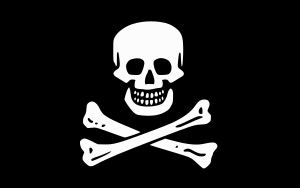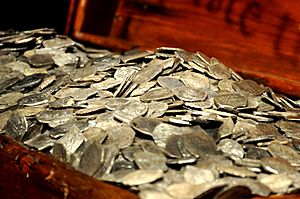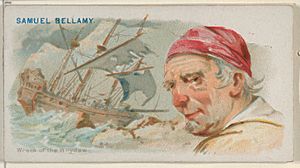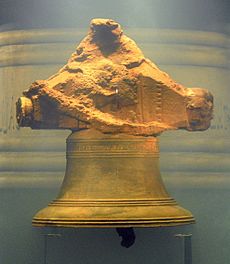Samuel Bellamy facts for kids
Quick facts for kids
Samuel Bellamy
|
|
|---|---|
| Born | c. 23 February 1689 Hittisleigh, Devon, Kingdom of England
|
| Died | April 26, 1717 (aged 28) |
| Piratical career | |
| Nickname | "Black Sam" Bellamy, "Prince of Pirates", "Black Bellamy", "Robin Hood of the Sea" |
| Type | Golden Age Pirate |
| Years active | 1716 – 26 April 1717 |
| Rank | Elected Commodore of pirate fleet |
| Base of operations | Blanco Islet, Tortola B.V.I. (later re-named Bellamy Cay), Caribbean Sea |
| Commands | Postillion, Sloop Marianne, Pinque Mary Anne, Sultana Galley, Whydah Gally, Anne, Fisher |
| Wealth | Equiv. US$163.1 million in 2022; #1 Forbes top-earning pirates |
Captain Samuel Bellamy (born around 23 February 1689 – died 26 April 1717) was an English sailor who became a famous pirate. He was known as "Black Sam" Bellamy and is considered one of the wealthiest pirates in history. He was a key figure during the Golden Age of Piracy.
Even though he was a pirate captain for just over a year, he and his crew captured at least 53 ships. People on Cape Cod called him "Black Sam" because he didn't wear a fancy powdered wig. Instead, he tied back his long, black hair with a simple band.
Bellamy was also known for being kind and fair to the people he captured. This earned him another nickname, the "Prince of Pirates". He even compared himself to Robin Hood, and his crew called themselves "Robin Hood's Men."
Bellamy was born in Devon, England, in 1689. He joined the British Royal Navy when he was a teenager. Around 1715, he traveled to Cape Cod. Then, he went south to Florida to search for a sunken treasure fleet.
From there, he sailed to the Bahamas. He joined the crew of pirate captain Benjamin Hornigold, whose second-in-command was Edward "Blackbeard" Teach. Later, Bellamy took command of a captured ship. In early 1717, he captured a modern slave trade ship called the Whydah Gally. Just two months later, the Whydah Gally sank in a storm off the coast of Massachusetts. Bellamy and most of his crew were lost with the ship.
In 1984, the remains of the Whydah Gally were found. It was the first confirmed pirate ship from the Golden Age discovered in North America.
Contents
Early life of Samuel Bellamy
Samuel Bellamy was born in 1689 in Hittisleigh, Devon, England. He was the youngest of six children. His mother died soon after his birth. Bellamy became a sailor when he was young. In his late teens, he joined the Royal Navy and fought in several battles.
Around 1715, Bellamy went to Cape Cod. Local stories say he had a connection with a local woman named Maria Hallett. Some legends say her parents didn't think a poor sailor was a good match for her. It's believed Bellamy wanted to find his fortune and then return for her.
In early 1716, Bellamy left Cape Cod with a group of men. They hoped to find treasure from the 1715 Treasure Fleet. This Spanish fleet had wrecked in a hurricane off Florida the previous summer. A wealthy jeweler named Paulsgrave Williams joined Bellamy and helped pay for their trip.
After Bellamy left, Maria Hallett faced difficulties. She was later exiled from the town. She then waited for Bellamy in Eastham.
Pirate career
The treasure hunters didn't find much success. So, they soon became pirates. They joined the crew of Captain Benjamin Hornigold. Hornigold's first mate was Edward Teach, who would later be known as "Blackbeard."
In the summer of 1716, the crew became unhappy with Hornigold. He didn't want to attack ships from England, his home country. The crew voted, and Hornigold was removed as captain of the Marianne. He left with his loyal followers, including Teach. The remaining 90 crew members then chose Bellamy as their new captain.
When they captured a second ship, the Sultana, it was turned into a galley. Bellamy took the Sultana as his own ship. He made his friend Palsgrave Williams the commander of the Marianne. They sailed with another pirate, Olivier Levasseur, for a short time.
Bellamy's biggest capture happened in the spring of 1717. He spotted the Whydah Gally (pronounced WHID-uh). This ship was built in England in 1715. It was a modern, 102-foot-long English slave ship with 18 guns. The Whydah was on its first voyage in 1716. It had just finished carrying slaves from Africa to the Caribbean. It was loaded with a huge amount of gold, indigo, ivory, and other valuable goods.
Bellamy chased the Whydah for three days. When he got close enough, he fired one shot. The Whydah's captain, Lawrence Prince, surrendered by lowering his flag. Bellamy was known for his generosity. He traded the Sultana for the Whydah as a reward for Prince's quick surrender. Bellamy then changed the Whydah to have 28 guns. He sailed his new flagship north along the eastern coast of the Carolinas and towards New England.
Captain Charles Johnson wrote an important book about pirates. It tells a story about the Whydah catching a small ship led by Captain Beer. Bellamy wanted Captain Beer to keep his ship. However, Bellamy's crew had voted to burn it. Captain Beer had also refused to join the pirates. Bellamy is said to have given a famous speech:
..... They insult us, the scoundrels do, when there is only this difference: they rob the poor under the cover of law, and we plunder the rich with our own courage. Wouldn't you rather join us than follow these villains for work?
[Beer said his conscience wouldn't let him break God's laws, and Bellamy continued]
You are a very strict person! I am a free prince. I have as much right to make war on the whole world as someone with a hundred ships and an army of 100,000 men. My conscience tells me this! But there's no arguing with such weak people, who let their superiors treat them badly.
Johnson's book mentions "Captain Bellamy" for these speeches. Some writers think it might have been another pirate named Charles Bellamy. Both operated at the same time, and their stories are sometimes mixed up.
Reputation of Black Sam
Captain Samuel Bellamy, or Black Bellamy, was known as a unique person. He was tall, strong, polite, and very neat. He liked expensive clothes, especially black coats.
As a captain, he led his crew almost like a democracy. His crew liked him very much. They sometimes called him "Robin Hood of the Sea" and themselves "Robin Hood's Men." Captain Bellamy was also a good planner. He usually had two ships. His main ship was strong with many cannons. The second ship was light and fast. This combination allowed them to capture ships easily without causing much damage.
Death of Captain Bellamy
Just two months after getting the Whydah, Bellamy and the Marianne were near Cape Cod. Williams told Bellamy he wanted to visit his family in Rhode Island. They agreed to meet again near Maine. Bellamy and the Whydah captured several other small ships in the area. He made his quartermaster, Richard Noland, captain of one of these, the Anne Galley.
On April 26, 1717, a strong storm hit the Whydah off Cape Cod at midnight. The ship was pushed onto sandbars in 16 feet of water, about 500 feet from the coast of what is now Wellfleet, Massachusetts. Fifteen minutes after midnight, the masts broke. The heavy ship sank quickly into 30 feet of water. Bellamy and all but two of the Whydah's 146 crew members were lost.
104 bodies were found washed ashore and buried. The Mary Anne also wrecked that night, a few miles south of the Whydah. Seven more survivors came from that ship. All nine survivors from both ships were captured. They were tried for piracy in Boston. Six were found guilty and hanged on November 15, 1717. Two were set free because the court believed they were forced into piracy. The last survivor, a 16-year-old Miskito Indian named John Julian, was believed to have been sold into slavery.
Williams waited for Bellamy, but he never appeared. Williams realized what had happened and sailed south to Nassau in the Marianne. Noland also searched for Bellamy off Maine. When he couldn't find him, he took the Anne Galley south. He raided ships along the way before accepting a pardon in the Bahamas.
Legacy of the Whydah Gally
In July 1984, Bellamy became famous again. The discovery of his flagship, the Whydah, was announced. It became the first confirmed pirate shipwreck ever found in North America. When it sank, the Whydah was the largest pirate treasure ever captured. It held about 4.5 to 5 tons of treasure. This included large amounts of indigo, ivory, gold, and 20,000 to 30,000 pounds sterling. The treasure was divided into 180 sacks, each weighing 50 pounds.
Underwater explorer Barry Clifford and his diving team found the wreck in 1982. The ship was under just 14 feet of water and 5 feet of sand.
In 1985, Clifford found the ship's bell. It had the words "THE WHYDAH GALLY 1716" on it. This was clear proof of his discovery. Clifford later opened The Whydah Pirate Museum in West Yarmouth, Massachusetts. It is dedicated to Bellamy and the Whydah. The museum has many items from the wreck. This includes a cannon found filled with precious stones, gold, and other artifacts.
Some of the 200,000 artifacts found so far went on a six-year tour around the United States. In 2022, a museum called Real Pirates opened in Salem, Massachusetts. It also shares information about Bellamy, the Whydah, and artifacts from the wreck.
In February 2018, suspected remains of Bellamy were found near his ship's wreck. The bones were close to a pistol believed to be his. DNA tests were done with a living relative to confirm. However, in May 2018, tests showed the bones were from an Eastern European man, not Bellamy.
In February 2021, Clifford announced that six more pirate bones were found. They will be tested for DNA matches once they are removed from the debris.
See also
 In Spanish: Samuel Bellamy para niños
In Spanish: Samuel Bellamy para niños






